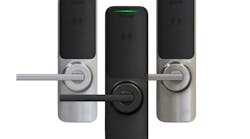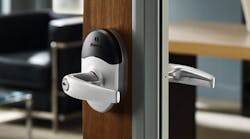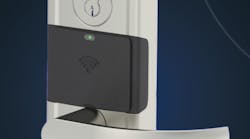We’re swimming in a sea of radio signals, the density of which grows with each passing day. A portion of these radio-frequency (RF) signals is security-related, be it from alarm sensors, detectors, wireless locks, keypads, cameras and the mobile devices to which we push data as well as use to control all those devices.
The world is more dependent on wireless connectivity, and it’s up to us to stay current with new developments. Whether it’s a complicated, high-tech access control system or a simple electronic lock, a wireless version is available, and the additional income that it provides is well-known and worth the effort.
Let’s look at three prevalent RF technologies, what they do and the devices and systems that they serve.
No. 1 Short-range Radio
The official definition of a “short-range wireless device,” according to the Federal Communications Commission (FCC) is: “a radio-frequency transmitter device used in telecommunication for the transmission of information, which has low capability of causing harmful interference to other radio equipment.”
In part, noninterference is what Part 15 of the FCC Rules & Regulations is about. Wireless security devices avoid interfering with registered and unregistered devices by virtue of their low transmission power, narrow pulse widths, a restriction on amplitude (AM-based devices), the type of modulation methodology and other technical criteria.
Although most of the wireless technologies involved in modern-day security could be classified as short range, for the sake of this story, we’ll include the following applications:
- Wireless intrusion alarms
- Wireless video-surveillance cameras
- Wireless access control
- Wireless vehicle-detection sensors
- Residential wireless smoke alarms
In the above applications, there might be fundamental differences in the technologies involved, such as the method of data modulation, length of transmissions (pulse duration), pulse width and such, but the one thing they all have in common is the direct application of security.
Using Narrowband RF
Traditional wireless commonly uses the narrowband 433-megahertz (MHz) and broadband 915-MHz spread spectrum. Transmitters in those frequencies come in the form of door switch sensors, wireless motion detectors, keypads without wires and even sirens that receive the command to sound off through the home electrical system to which they attach.
Where narrowband RF features encrypted data modulated onto a 433-MHz carrier signal, spread-spectrum systems use multiple frequencies in such a manner that other RF sources can’t interfere with reception or transmission. Narrowband operation won’t hamper traditional licensed services because of reduced signal strength and short signal duration.
Inovonics, for example, uses spread-spectrum technology in its line of products, which includes the following:
- Analog current and voltage data transmitters
- Analog temperature and humidity transmitters
- Water detectors
- Temperature sensors
- Carbon dioxide detectors
- Differential pressure transducers
These are in addition to a full complement of wireless fire and security devices.
Using Broadband RF
Without a doubt, the use of broadband spread spectrum is far less than that of traditional narrowband.
Nortek Controls (formerly Linear) has an assortment of wireless products, such as the Xtended Range transmitter/receiver. Composed of paired transmitter-and-receiver units, these units come in one-, four- and 16-channel combinations, so you can control up to a like number of devices at a remote location. Examples include, but certainly aren’t limited to the following:
- Turnstiles
- Motorized vehicle gates
- Lights
- Live camera views
In addition, there is the tried-and-true, single-channel garage door opener.
DSC offers a wireless handheld transmitter that uses short-range RF that can be programmed to control lights as well as a garage door, the arm/disarm function of an alarm system and a panic-alarm button. DMP also offers wireless keypads, door/window transmitters, motion detectors and more.
Additional makes and models of wireless systems are capable of adapting to any other manufactured wireless transmitter. Alula’s security system, in particular, comes equipped with several wireless technologies, including cellular 4G and 5G for primary or secondary communications with a central monitoring system (CMS).
No. 2 WPAN
Wireless personal area networks (WPAN’s) serve computerized electronic devices in the immediate area of an individual(s). They’re used to interconnect computers, printers, mobile devices and a variety of other devices. This can include connectivity between a small workspace and a larger network within a home or commercial facility.
The most common wireless technologies used for this purpose include Bluetooth, ZigBee, Z-Wave and near field communication (NFC). In security, the most common applications might include the interconnection of an electronic door lock with an alarm control panel, the control of appliances, such as heating and cooling equipment and interaction between mobile devices and electronic locks.
Smartphones equipped with NFC can send access data to corresponding access readers by merely passing near to them.
The Use of Bluetooth
Bluetooth is a short-distance technology designed to allow data transference between devices, such as a smartphone and a door lock on a commercial business or home.
The technology was invented by Jaap Haartsen, a Dutch engineer, and now it’s managed by the Bluetooth Special Interest Group (SIG). This SIG is composed of more than 30,000 companies that use it for telecommunications, computing, networking and consumer electronics. In the security business, we use it, as mentioned, to send data to and from a smartphone or tablet to an electronic wireless lock.
A good example of this is DSC’s Touch 7-inch All-in-One TouchScreen. According to DSC, the smart panel integrates with Alarm.com to manage home-security capability. Alarm.com is a comprehensive home-control platform that you can use to make additional recurring monthly revenue by reselling the service to your customers.
The DSC display keypad allows up to 242 role-based user codes, which grant programming access to people based on their “role.” The six access levels include dealer PIN, installer, master code, regular user, a guest code for one-time use (if desired) and one that generates a duress alarm. Duress is used when the end user has to deactivate the system in a normal manner without making a criminal who’s holding them hostage aware that a silent duress signal was sent to the central monitoring station. All of this is made possible through the use of WPAN technologies.
Another example of an alarm system that uses WPAN technologies with mobile devices in conjunction with cellular or internet access and Wi-Fi connectivity is the DMP 738Zplus module, which allows users to control a variety of devices in their home or small business, including connected Z-Wave devices.
No. 3 Wi-Fi
We’re seeing the proliferation of Wi-Fi in the security world. Most of us aren’t aware of it, but Wi-Fi is an acronym of sorts for the term “wireless fidelity.” It’s actually a technical standard developed by the IEEE (Institute of Electrical and Electronics Engineers).
Modern security systems increasingly use 2.4-gigahertz (GHz) Wi-Fi for an assortment of purposes. It’s used for transmitters as well as communication with a CMS. Although this method of wireless typically is free of technical snags, there are times when it isn’t robust and suitable from the standpoint of transmission distance.
When coverage becomes a problem, this is when repeaters come into play. The other method used to increase range in the Wi-Fi 2.4-GHz band is to use more than one gateway. In most cases, when used in this manner, all connected gateways act as a single processing point.
Security systems as well as electronic locks use Wi-Fi. Wireless access points provide connectivity between controllers, local area networks, alarm panels, the internet, video cameras, locks, keypads, readers, transmitters fastened to doors and windows, and more.
No matter which wireless technology you work with, you’re assured of one thing — that your client expects wireless technology. With a little bit of effort, you can learn the positives and negatives associated with each one to determine which system is right for any and all situations.
Allan B. Colombo is a longtime trade journalist and professional in the security and life-safety markets. Contact him at [email protected], 330-956-9003 or www.tpromocom.com.






